For the 2025 school year, there are 2 public charter schools serving 242 students in Coos Bay SD 9 School District. This district's average charter testing ranking is 4/10, which is in the bottom 50% of public charter schools in Oregon.
Public Charter Schools in Coos Bay SD 9 School District have an average math proficiency score of 29% (versus the Oregon public charter school average of 35%), and reading proficiency score of 47% (versus the 51% statewide average).
Minority enrollment is 28% of the student body (majority Hispanic), which is equal to the Oregon public charter school average of 28% (majority Hispanic).
Overview
This School District
This State (OR)
# Schools
9 Schools
133 Schools
# Students
2,965 Students
42,875 Students
# Teachers
160 Teachers
2,179 Teachers
Student : Teacher Ratio
19:1
19:1
District Rank
Coos Bay SD 9 School District, which is ranked within the bottom 50% of all 186 school districts in Oregon (based off of combined math and reading proficiency testing data) for the 2021-2022 school year.
The school district's graduation rate of 69% has increased from 62% over five school years.
Overall District Rank
#126 out of 189 school districts
(Bottom 50%)
(Bottom 50%)
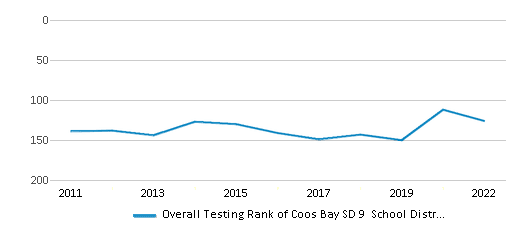
Math Test Scores (% Proficient)
23%
31%
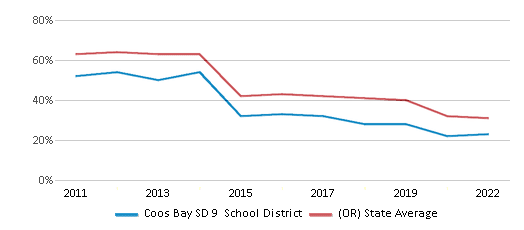
Reading/Language Arts Test Scores (% Proficient)
38%
44%

Science Test Scores (% Proficient)
24%
30%
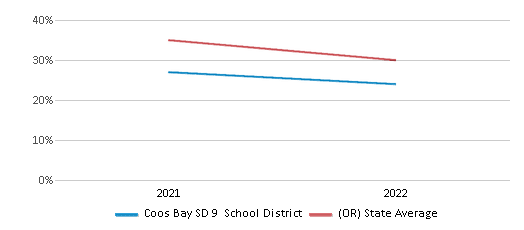
Graduation Rate
69%
81%
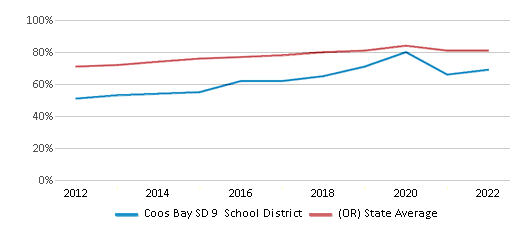
Students by Ethnicity:
Diversity Score
0.46
0.46
# American Indian Students
81 Students
536 Students
% American Indian Students
3%
1%
# Asian Students
23 Students
856 Students
% Asian Students
1%
2%
# Hispanic Students
422 Students
6,208 Students
% Hispanic Students
14%
15%
# Black Students
13 Students
883 Students
% Black Students
1%
2%
# White Students
2,137 Students
30,712 Students
% White Students
72%
72%
# Hawaiian Students
12 Students
149 Students
% Hawaiian Students
n/a
n/a
# Two or more races Students
261 Students
3,155 Students
% of Two or more races Students
9%
8%
Students by Grade:
# Students in PK Grade:
-
-
# Students in K Grade:
200
2,938
# Students in 1st Grade:
236
3,297
# Students in 2nd Grade:
225
3,497
# Students in 3rd Grade:
228
3,445
# Students in 4th Grade:
268
3,447
# Students in 5th Grade:
226
3,422
# Students in 6th Grade:
242
3,364
# Students in 7th Grade:
210
3,333
# Students in 8th Grade:
231
3,553
# Students in 9th Grade:
234
2,757
# Students in 10th Grade:
222
3,042
# Students in 11th Grade:
234
3,359
# Students in 12th Grade:
209
3,421
# Ungraded Students:
-
-
District Revenue and Spending
The revenue/student of $16,868 in this school district is less than the state median of $18,279. The school district revenue/student has stayed relatively flat over four school years.
The school district's spending/student of $24,973 is higher than the state median of $19,325. The school district spending/student has stayed relatively flat over four school years.
Total Revenue
$50 MM
$9,902 MM
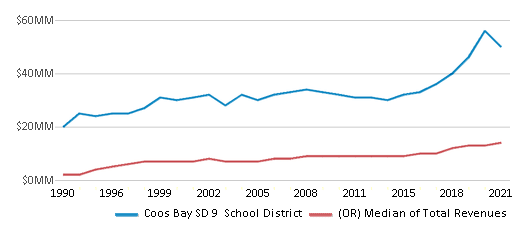
Spending
$74 MM
$10,468 MM
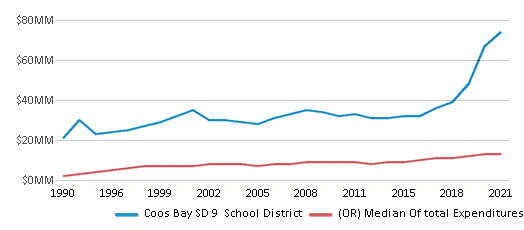
Revenue / Student
$16,868
$18,279
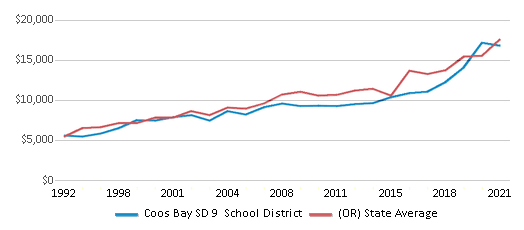
Spending / Student
$24,973
$19,325
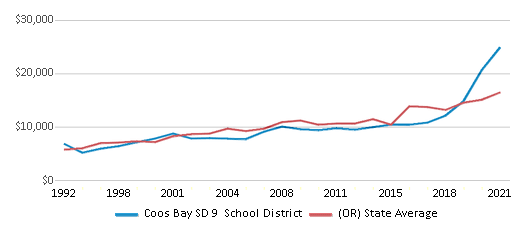
Best Coos Bay SD 9 School District Public Charter Schools (2025)
School
(Math and Reading Proficiency)
(Math and Reading Proficiency)
Location
Grades
Students
Rank: #11.
Resource Link Charter School
Charter School
(Math: <50% | Reading: ≥50%)
Rank:
Rank:
8/
Top 30%10
1255 Hemlock Ave
Coos Bay, OR 97420
(541) 267-1485
Coos Bay, OR 97420
(541) 267-1485
Grades: K-12
| 37 students
Rank: #22.
Lighthouse Charter School
Charter School
(Math: 25-29% | Reading: 45-49%)
Rank:
Rank:
6/
Top 50%10
62858 Hwy 101
Coos Bay, OR 97420
(541) 751-1649
Coos Bay, OR 97420
(541) 751-1649
Grades: PK-8
| 205 students
Recent Articles

Year-Round Or Traditional Schedule?
Which is more appropriate for your child? A year-round attendance schedule or traditional schedule? We look at the pros and cons.

Why You Should Encourage Your Child to Join a Sports Team
Participating in team sports has a great many benefits for children, there is no doubt. In this article you will learn what those benefits are.

White Students are Now the Minority in U.S. 九游体育s
Increasing birth rates among immigrant families from Asia and Central and South America, combined with lower birth rates among white families, means that for the first time in history, public school students in the United States are majority-minority. This shift in demographics poses difficulties for schools as they work to accommodate children of varying language abilities and socio-economic backgrounds.





